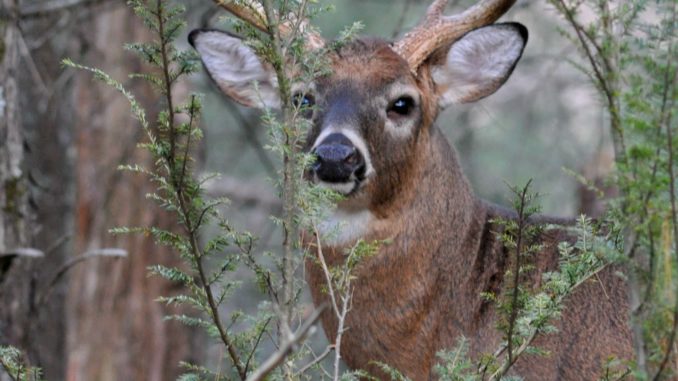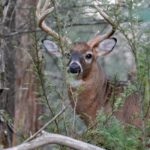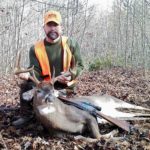
Food, cover, bedding areas and escape routes are keys to finding trophy deer hotspots in November.
Although whitetails are in the rut from October’s final days through November, success afield doesn’t always depend on the presence of the mature bucks that are the target of most hunters.
A variety of factors can influence a successful November hunt, the most important, ironically, the presence of mature does, and size — of a hunting area — doesn’t matter when it comes to good trophy buck hunting areas.
The accounts of two successful North Carolina hunters last November prove those points.
Jon Tilley of Mooresville, was lucky to have a father-in-law who owns a small 65-acre Christmas tree farm in Surry County. That isn’t a lot of land, but the property has characteristics that draw whitetails like a magnet during the rut.
“He’s had the property for years,” said Tilley, 48. “It’s a weekend getaway place for the family and a great place to hunt.”
For 15 years, Tilley and various family members have planted food plots to attract whitetails.
“We have a unique situation,” he said. “Most of (the) land was cut over and replanted in pines, but our farm also has small fields where we plant brassicas (leafy turnips, rape, mustard greens and wintergreen).
“Brassica leaves are bitter until after the first two frosts, then the leaves become sugary, and deer mow them down, which is perfect for November,” Tilley said. “We also plant oats.”
Even with hunting pressure on property around the farm, its terrain creates a deer haven. A long, east-to-west gully splits the cutover. The 30-foot wide ditch, which is 20 feet deep, has thick laurel at its bottom, along with some tall poplar trees in the gully and near its edges. A few hardwoods at the gully’s east end border a neighbor’s large corn field. At the west end are more hardwoods, deep draws and laurel-thicket bedding areas.
“We hunt from climbing stands about 30 feet up in poplar trees so we can see into the gully and the trail at the opposite side,” Tilley said. “Deer trails follow the top edges of the gully on both sides. We watch for deer walking from the corn field or from our food plots to the western hardwoods and the bedding area. The gully is a pinch point, an easy way for deer to cross the clear cut.”
Last Nov. 29, Tilley, ratcheted his Summit Viper climbing stand high into a poplar tree at 6 a.m. and sat ready with his .44 Marlin lever-action rifle with a fixed 2-power scope.
“It’s a short-range rifle, a brush gun,” he said.
During past bow seasons, trail cameras had captured images of a big-bodied buck in velvet at a food-plot corn feeder, and Tilley’s nephew had downed a decent buck with a similar rack three years earlier, indicating a good local gene pool. Another family member also got a glimpse of a large buck a week earlier at the cutover’s edge.
“I killed two nice 8-pointers out of the same tree a year earlier,” Tilley said. “I only hunt in the morning to catch deer moving from the corn to their bedding area.”
At 7:30 a.m., a small buck walked down the opposite slope and stopped at an open spot with sunlight.
“It was a cold morning, in the low 20s, the wind was good, too, blowing up the hill,” Tilley said. “You can only hunt these gully stands with wind in your face.”
Within a few minutes, dogs at a neighbor’s home began barking at deer walking from the corn field and across the neighbor’s yard toward of the gully. Then Tilley heard another deer walking above the small buck. That deer walked toward the footsteps.
“Then I heard a dominant buck grunt, and (the small buck) ran down the hill with his tail between his legs,” he said.
Another dog barked, and soon, a huge whitetail scurried down the hill, crossed the gully and walked within 12 steps of Tilley’s tree. His .44-caliber bullet slammed the buck’s front shoulder as it looked over its shoulder toward the barking dog.
“He ran about 30 yards and piled up,” Tilley said.
The near-perfect 5×5 rack scored 147 6/8 gross and 144 6/8 net inches at a whopping 225 pounds.
“If you have thick cover you know deer like to travel, that’s the place to be,” Tilley said.
***
Steven Burnette of Mount Pleasant hunted an even smaller farm to kill his deer of a lifetime during the November 2014 rut.
“I have 52 acres in Caswell County that joins a 30-acre farm owned by my uncle and dad,” Burnette said. “We have eight food plots planted, mostly with clover, feeders and use trail cameras to try to see bigger bucks.”
The 12-pointer he downed Nov. 19, 2014, had a 4×4 main frame and four sticker points, totaling 160 5/8 gross and 149 5/8 net inches.
“He was chasing a doe opening week of gun season,” said Burnette, who had seen the buck in trail-camera photos 500 to 600 yards from a box stand that overlooked a large food plot with a corn feeder 60 yards from his stand.
“He came out of a cutover across the field, turned left and walked to check four scrapes along the edge,” Burnette said. “A doe was near the feeder when he came out of the woods. I wanted to shoot, but I was shaking so bad I had to take the safety off.”
From the same stand where he’d killed an 8-point buck the previous day, Burnette watched the buck check the scrapes, then head for the doe.
“I shot him in the right shoulder with my Remington pump .30-06 at 60 yards,” Burnette said. “He fell in his tracks.”
Unlike Tilley, Burnette’s prime times for buck luck are evenings.
“But I stay away from stands until I go hunting,” he said. “To not alert deer, I’ll fill a feeder then leave for two weeks.”
When he hunts the box stand, he doesn’t use cover or buck-lure scents “because I’m enclosed and scent doesn’t get out,” he said. “I can hunt that stand no matter the wind direction. But we have tripod and ladder stands where we use cover scents and are careful of wind direction.”
The deer weighed 186 pounds.






Be the first to comment